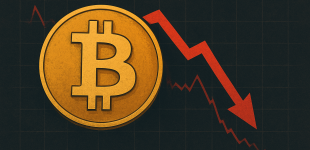
Introduction
Bitcoin markets are on edge as traders brace for the release of the United States Consumer Price Index (CPI) report, a key inflation metric that could have significant implications for both Federal Reserve policy and the near-term direction of cryptocurrency prices. Analysts warn that the coming days may see heightened volatility in Bitcoin, with macroeconomic forces and crypto-specific market dynamics colliding to create a potentially turbulent trading environment.
The CPI report, due later this week, will provide a snapshot of inflationary pressures across the US economy. For traditional markets, this data can be a major driver of asset prices, as it shapes expectations for interest rate moves by the Federal Reserve. For Bitcoin, however, the stakes are equally high — if not higher — given its sensitivity to changes in global liquidity and investor risk appetite.
Macroeconomic Crossroads For Bitcoin
Over the past several months, Bitcoin has increasingly behaved like a high-beta asset — rising and falling in tandem with risk-on sentiment in broader financial markets. This correlation has grown stronger as institutional investors have deepened their exposure to Bitcoin through spot ETFs and other regulated investment vehicles.
The Federal Reserve’s policy path is now a major determinant of that sentiment. Higher interest rates generally lead to tighter financial conditions, which can suppress speculative assets like Bitcoin. Conversely, the prospect of rate cuts tends to encourage risk-taking and can provide a tailwind for crypto prices.
If the upcoming CPI print comes in hotter than expected, markets could quickly shift to pricing in fewer or later rate cuts, potentially putting pressure on Bitcoin in the short term. On the other hand, a cooler-than-expected CPI reading could fuel optimism that the Fed will loosen policy sooner, giving Bitcoin a boost.
The Role Of Inflation In Crypto Market Narratives
Inflation data has long played a complex role in Bitcoin’s market narrative. On one hand, Bitcoin’s fixed supply of 21 million coins is often touted as an inflation hedge, similar to gold. On the other hand, Bitcoin’s actual trading history shows that it often reacts more to liquidity conditions than to inflation itself.
In 2021, during a period of surging inflation, Bitcoin reached all-time highs as unprecedented monetary stimulus and low interest rates flooded markets with capital. However, as inflation persisted into 2022 and central banks turned to aggressive tightening, Bitcoin suffered a prolonged bear market. This pattern underscores how Bitcoin’s relationship with inflation is mediated by monetary policy.
Current Market Positioning And Technical Landscape
As of mid-August 2025, Bitcoin is trading just below the $65,000 mark, having recently rallied on speculation that the Fed could soon shift toward rate cuts. This rally, however, has left the market in a technically sensitive position.
Several key resistance levels lie just above the current price, with the $66,500 to $67,000 range marking a zone where sellers have historically stepped in. On the downside, support can be found near $63,000, a level that has held during recent pullbacks. A decisive break in either direction could set the tone for the weeks ahead.
Trading volumes have been robust, suggesting strong participation from both institutional and retail investors. However, derivatives data shows an uptick in leveraged long positions, raising the risk of a sharper downside move if sentiment suddenly turns.
Institutional Flows And The ETF Effect
One of the most significant developments in Bitcoin markets over the past year has been the surge in institutional participation via spot Bitcoin ETFs. These products have attracted billions of dollars in inflows, giving large investors an easy way to gain exposure without dealing directly with crypto exchanges or custody solutions.
Recent ETF flow data shows a renewed wave of buying interest, with some funds posting record daily inflows in early August. This has provided a floor under Bitcoin’s price in recent weeks, even as macroeconomic uncertainty has loomed.
If CPI data surprises to the upside, however, risk assets could come under pressure, leading to potential outflows from these ETFs. The speed at which institutional capital can move in and out of Bitcoin through these vehicles adds an extra layer of volatility risk to the market.
Mining Sector Resilience Despite Challenges
Beyond price action and investor flows, Bitcoin’s underlying network fundamentals remain robust. Mining difficulty recently hit an all-time high, indicating continued investment in mining infrastructure despite rising operational costs.
This resilience is notable given that energy prices remain elevated in many parts of the world, and the halving event earlier this year reduced the block reward from 6.25 BTC to 3.125 BTC. Miners are increasingly relying on high-efficiency equipment and renewable energy sources to maintain profitability.
From a market perspective, strong mining activity reinforces the security of the Bitcoin network, which can bolster long-term investor confidence even during periods of price volatility.
Whales And Market Sentiment
On-chain data reveals that large Bitcoin holders — often referred to as “whales” — have been accumulating in recent weeks. According to blockchain analytics firms, wallets holding over 1,000 BTC have collectively added billions of dollars’ worth of Bitcoin to their positions since late July.
This accumulation trend is often viewed as a bullish signal, suggesting that sophisticated market participants are positioning for higher prices. However, whale buying can also be a double-edged sword, as large holders can exert outsized influence on short-term price moves if they decide to sell.
Geopolitical Factors And Bitcoin’s Global Demand
While US monetary policy is currently the dominant macro driver for Bitcoin, geopolitical developments are also shaping demand patterns. Economic instability in several emerging markets has led to increased interest in Bitcoin as a store of value and a tool for capital preservation.
In countries facing currency devaluation or capital controls, peer-to-peer Bitcoin trading volumes have surged, according to data from various analytics platforms. This grassroots adoption is an important reminder that Bitcoin’s value proposition extends beyond its role as a speculative asset in developed markets.
The Week Ahead: Scenarios For Bitcoin Post-CPI
As traders look ahead to the CPI release, several scenarios are in play.
If CPI comes in lower than forecast, Bitcoin could see a sharp rally as markets price in earlier rate cuts. This could push prices above key resistance levels, potentially setting the stage for a retest of the $70,000 zone.
If CPI meets expectations, Bitcoin might trade in a relatively narrow range, with volatility picking up only if the Fed’s subsequent commentary signals a policy shift.
If CPI surprises to the upside, Bitcoin could face significant selling pressure, particularly if leveraged long positions are forced to unwind. In this case, a drop toward the $60,000 support area would not be out of the question.
Long-Term Outlook Remains Constructive
Regardless of near-term volatility, many analysts maintain a constructive view on Bitcoin’s long-term prospects. The combination of a fixed supply, growing institutional adoption, and expanding use cases in emerging markets continues to underpin a bullish structural narrative.
Moreover, technological developments such as the Lightning Network are making Bitcoin transactions faster and cheaper, potentially broadening its utility beyond investment and speculation.
Conclusion
The days ahead could prove pivotal for Bitcoin, as macroeconomic data and central bank policy converge to shape market sentiment. While the CPI report is just one data point in a complex economic landscape, its impact on interest rate expectations makes it a key catalyst for both traditional and crypto markets.
For traders, the message is clear: prepare for potential price swings and manage risk accordingly. For long-term holders, the underlying fundamentals of Bitcoin remain intact, suggesting that volatility may be more of an opportunity than a threat. In either case, the coming week promises to be an important chapter in Bitcoin’s ongoing story — one that will be closely watched not just by crypto enthusiasts, but by the broader financial world.







There are no comments at the moment, do you want to add one?
Write a comment